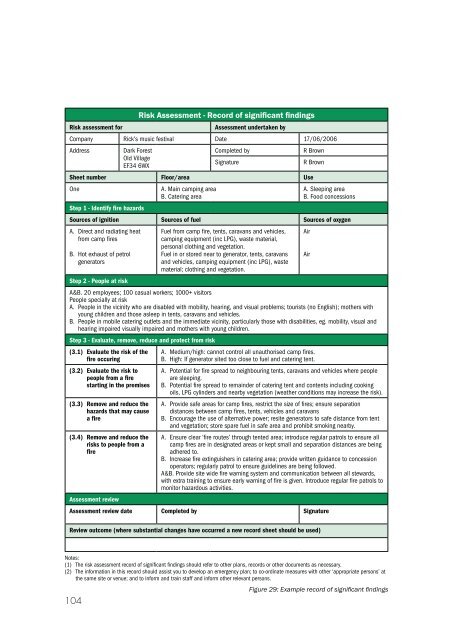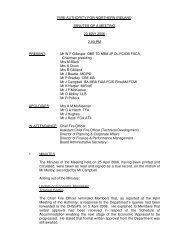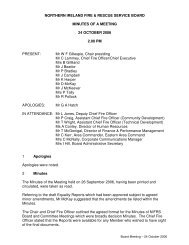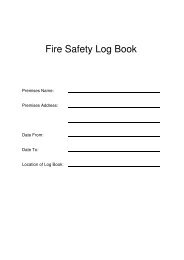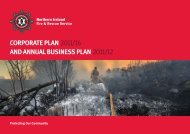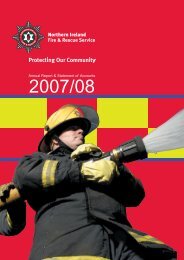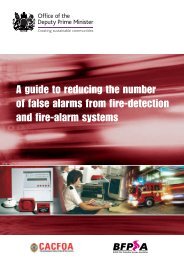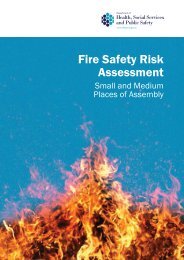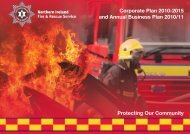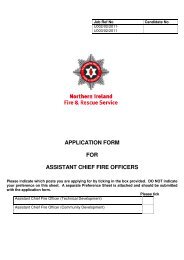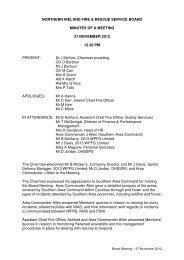Open-Air-Events-and-Venues-NI-Fire-Safety-Guide-Final-Draft-from ...
Open-Air-Events-and-Venues-NI-Fire-Safety-Guide-Final-Draft-from ...
Open-Air-Events-and-Venues-NI-Fire-Safety-Guide-Final-Draft-from ...
- No tags were found...
You also want an ePaper? Increase the reach of your titles
YUMPU automatically turns print PDFs into web optimized ePapers that Google loves.
Risk Assessment - Record of significant findingsRisk assessment forAssessment undertaken byCompany Rick’s music festival Date 17/06/2006Address Dark ForestCompleted byR BrownOld VillageEF34 6WXSignatureR BrownSheet number Floor/area UseOneA. Main camping areaB. Catering areaA. Sleeping areaB. Food concessionsStep 1 - Identify fire hazardsSources of ignition Sources of fuel Sources of oxygenA. Direct <strong>and</strong> radiating heat<strong>from</strong> camp firesB. Hot exhaust of petrolgeneratorsFuel <strong>from</strong> camp fire, tents, caravans <strong>and</strong> vehicles,camping equipment (inc LPG), waste material,personal clothing <strong>and</strong> vegetation.Fuel in or stored near to generator, tents, caravans<strong>and</strong> vehicles, camping equipment (inc LPG), wastematerial; clothing <strong>and</strong> vegetation.Step 2 - People at riskA&B. 20 employees; 100 casual workers; 1000+ visitorsPeople specially at riskA. People in the vicinity who are disabled with mobility, hearing, <strong>and</strong> visual problems; tourists (no English); mothers withyoung children <strong>and</strong> those asleep in tents, caravans <strong>and</strong> vehicles.B. People in mobile catering outlets <strong>and</strong> the immediate vicinity, particularly those with disabilities, eg. mobility, visual <strong>and</strong>hearing impaired visually impaired <strong>and</strong> mothers with young children.Step 3 - Evaluate, remove, reduce <strong>and</strong> protect <strong>from</strong> risk(3.1) Evaluate the risk of thefire occuring(3.2) Evaluate the risk topeople <strong>from</strong> a firestarting in the premises(3.3) Remove <strong>and</strong> reduce thehazards that may causea fire(3.4) Remove <strong>and</strong> reduce therisks to people <strong>from</strong> afireA. Medium/high: cannot control all unauthorised camp fires.B. High: If generator sited too close to fuel <strong>and</strong> catering tent.A. Potential for fire spread to neighbouring tents, caravans <strong>and</strong> vehicles where peopleare sleeping.B. Potential fire spread to remainder of catering tent <strong>and</strong> contents including cookingoils, LPG cylinders <strong>and</strong> nearby vegetation (weather conditions may increase the risk).A. Provide safe areas for camp fires, restrict the size of fires; ensure separationdistances between camp fires, tents, vehicles <strong>and</strong> caravansB. Encourage the use of alternative power; resite generators to safe distance <strong>from</strong> tent<strong>and</strong> vegetation; store spare fuel in safe area <strong>and</strong> prohibit smoking nearby.A. Ensure clear ‘fire routes’ through tented area; introduce regular patrols to ensure allcamp fires are in designated areas or kept small <strong>and</strong> separation distances are beingadhered to.B. Increase fire extinguishers in catering area; provide written guidance to concessionoperators; regularly patrol to ensure guidelines are being followed.A&B. Provide site wide fire warning system <strong>and</strong> communication between all stewards,with extra training to ensure early warning of fire is given. Introduce regular fire patrols tomonitor hazardous activities.Assessment reviewAssessment review date Completed by SignatureReview outcome (where substantial changes have occurred a new record sheet should be used)<strong>Air</strong><strong>Air</strong>Notes:(1) The risk assessment record of significant findings should refer to other plans, records or other documents as necessary.(2) The information in this record should assist you to develop an emergency plan; to co-ordinate measures with other ‘appropriate persons’ atthe same site or venue; <strong>and</strong> to inform <strong>and</strong> train staff <strong>and</strong> inform other relevant persons.104Figure 29: Example record of significant findings


